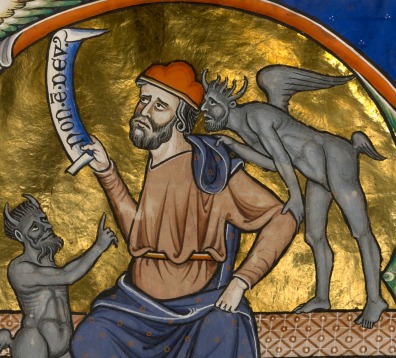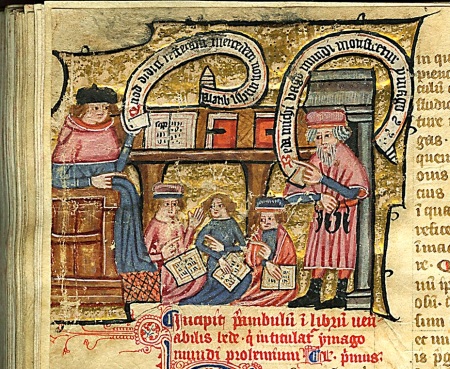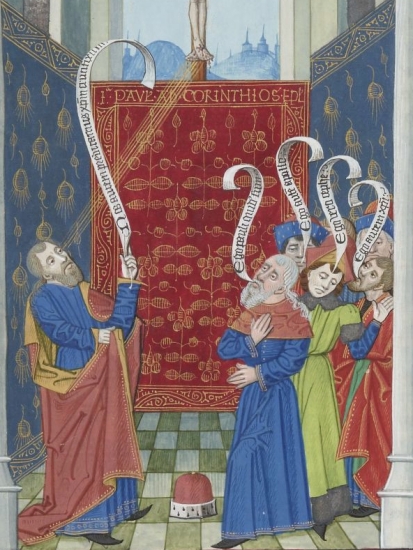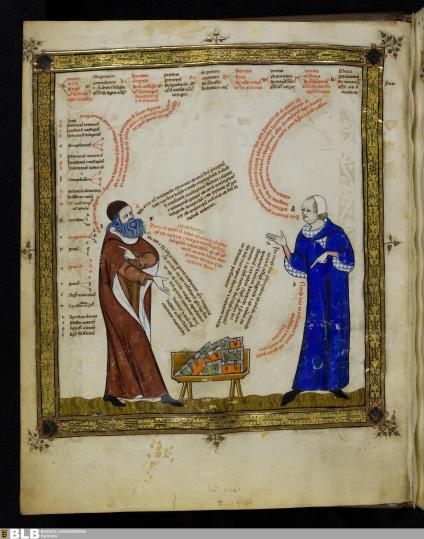This blog frequently highlights parallels between medieval and modern technology and media. My recent posts on Spam, GPS and Selfies in medieval times are good examples of that. As odd as this may sound, as a medieval book historian I see such parallels with modern concepts all the time: all you need is a pair of eyes and a little imagination. A few days ago, however, I encountered (and tweeted) a parallel I had never seen before: a drawing with the appearance of a page from a modern comic book (Fig. 1, tweet here).

The drawing from c. 1300 shows a group of people walking, some of them with a walking stick in their hand. You can almost hear the sing-songs in the background. As it turns out, this merry scene bears more than one parallel to a modern comic book story.
Speech bubbles
According to the description of the British Library we are looking at a group of travellers conversing in English. What the description does not mention, however, is something that is rarely seen in medieval drawings: the different parts of conversation are given the appearance of speech bubbles. That is to say, just like in modern comic books, sentences are visually connected to the individual who utters them, by means of a tiny line (Fig. 2).

Also in parallel to modern comic books, the story that unfolds is funny and familiar. The art historian Lucy Freeman Sandler has devoted considerable attention to this scene (a transcription and literal translation is found in this publication). Using her work, while rewording her literal translation, the following conversation may be overheard:
The figure on the left starts, with a strange mantra: “They die because of heat, they die because of heat.” Then the two young people on his right speak, probably addressing their father [according to Sandler], who is walking behind them: “Sir, we die of cold!” The father, carrying a heavy toddler, orders them to stop whining: “Behold your little brother in front of us, he is only wearing a hood.” (He is right, because he is otherwise naked.) Then the toddler speaks, uttering universal toddler sounds: “Wa we”. Finally the two children in the back come into play (Fig. 2). “Sir, I am carrying too much weight,” says the one on the left. The one on the right closes the conversation by comparing his own misery to that of his brother and father, stating “It is not they who carry the heaviest burden.”
The Middle English scene is familiar to many of us. We are shown a family en route to an unknown location (as if it were an alternative version of the Canterbury Tales). The young ones are verbally poking at each other, and complain about the temperature and the weight of their suitcases. It is the medieval version of a modern parent’s nightmare: being on the road with a crying toddler and whiny kids that egg each other on. “Are we there yet?”
Banderole

Books before print had another way to make a silent figure on the page speak: the banderole. This clever device gave the decorator the ability to make someone deliver a short statement. Short, because it had to fit on a tiny scroll (see a collection of them here and in this blog post). In Fig. 3, for example, we see a fool repeat the words whispered in his ear by the devil: “There is no God” (Non est deus). The speaker holds the tip of the scroll in his hand, so as to claim the words as his own. It also happened that the speaker was pointing at the banderol, often touching it with his finger.

Such points of contact (holding the scroll or touching it) were particularly important when an image presented more than one speaking person. It allowed the viewer to identify who was saying what. Fig. 4 shows a classroom where two teachers appear to be in a lively debate. One is holding the scroll, the other is pointing at it, each firmly securing the text to their own person.
Interesting in light of the comic book parallel is that the banderole was not always held in or close to the speaker’s hand: it could also flow from his or her mouth. While such cases are less common, they have a strikingly modern appearance because of the banderole’s white background, which creates the illusion of a real text bubble (Fig. 5).


Not all banderoles present such a “live” text. Some label a scene, while others clarify the identity of a person. For example, the banderole in Fig. 6 introduces the twelfth-century illuminator Guda, who decorated the book in question, but it does not present direct speech (more about the image in this post). Instead, it is the medieval equivalent of tagging a person in an image.
No bubbles
Then there are, finally, manuscripts where direct speech is written in mid air, unsupported by a banderole or a bubble. In order to relate the uttered text to a given person, the scribe wrote the lines in such a way that they appeared to flow from the speaker’s mouth. The result are wavy lines of text that dance across the page. A great example is seen in Fig. 7. This miniature is part of a cycle on the life and work of the scholar Raymond Lull (d. 1316). Here he is shown discussing with Thomas Méysier, his student and disciple. The images in the cycle were made under personal supervision of Thomas, who also compiled the contents of the manuscript, which presents a compilation of Lull’s work called the Electorium parvum sue breviculum (more here).

Although serious in subject matter, the conversation between the master and the student has a funny, almost grotesque appearance. Over a big and authoritative pile of books we see the scholars engaged in a lively discussion. Arguments fly across the page. It looks like the scribe is trying to help the viewer keep track of the discussion through the use of different colours (red and black). Also, the scribe presents the conversation in such a way that each component begins with a line that sticks out slightly. Cleverly, the extended tip is found next to the speaker’s mouth, leaving no doubt as to who is saying what. No bubble required.
Acknowledgments – I wish to thank Thijs Porck (Leiden) for his help with the Middle English translation of the scene in Fig. 1. My PhD student Jenneka Janzen (Leiden) introduced me to the Karlsruhe manuscript in Fig. 7.


Bedankt voor de tip! Een heel mooi voorbeeld van een ballon dialoog. Niet de oudste in de wereld, wel een schitterend geval.
LikeLike
Het is wat laat, maar ik kom hier nu pas langs. Ik wilde wijzen op de middeleeuwse ‘strip’ in het stedelijk archief van Zutphen uit 1493. https://www.lambiek.net/aanvang/1800.htm
Groeten,
Joost Hölscher
LikeLike
Reblogged this on Neunte Kunst (http://comics.hypotheses.org/129).
LikeLike
Reblogged this on ilripassinodimatematica and commented:
Si dice che ” tutto il mondo è paese ” … Vale anche per le epoche storiche ! Ecco un bell’articolo che svela la passione per lo storytelling e il fumetto anche nel lontano medioevo. Approfittiamone, ora che è di moda il vintage!!!
LikeLike
Dank u wel! Elke leraar (in figuur 4) lijkt te praten met een leerling ….
LikeLike
I hope to see it in April!
LikeLiked by 1 person
These are lovely! I saw the Book of Kells in Ireland, and it was absolutely beautiful.
LikeLike
Reblogged this on Rolling Chrome and commented:
Comics have always been in fashion. Good to know. What would Umberto Eco say?
LikeLike
The words read – in Latin – “non est deus” [actually deu-us], which is also what other scholars have read. There is no s missing as it is embedded in the us-abbreviation (the curl). I’m inclined to stick with the traditional Latin reading.
LikeLike
I’m curious — about “non ē dev.” You gloss it as Latin: “non est deus”, but isn’t that only half the story? My first reaction was that it was likely to be a vernacular Romance version of the sentence, and that the loss of the terminal -st and -s would be consistent with the langues d’Oïl local to Noyon.
LikeLike
I like the comparison – thanks for your comment.
LikeLike
There’s another good example of how the medieval cartoons look like: a Bayeux Tapestry, an extremely long (70m!) cloth swathe with the history of Noman conquest of England on it, from its very beginning to the Battle of Hastings (there was probably something more, but the last scenes were destroyed or cut off). It presents a sequence of circa 50 scenes with Latin descriptions, reminding viewers of today photo stories in newspapers or cartoons. The only thing it lacks is the speech bubbles:)
LikeLike
Thanks for your comment!
LikeLike
Reblogged this on Creating an Illustrated Textbook From Scratch and commented:
As a history teacher, I always notice manuscripts and other illustrations that use speech bubbles. Mesoamerican codices as well as Spanish friar translations include symbols that show speech happening.
LikeLike
Thanks for your comment
LikeLike
Not a book, but I thought right away of the graffiti of San Clemente. http://paolaghione.blogspot.com/2011/04/il-medioevo-e-il-fumetto.html
LikeLike
Graag gedaan
LikeLike
Dank!
LikeLike
Your welcome – thanks for visiting!
LikeLike
This is so fascinating. Thank you!
LikeLike
Great to see all these calligraphic goodies,really wonderful,tahnk you so much,a real treat, gald to see that there so much interrest still.
LikeLike
Reblogged this on Going Medieval and commented:
Medieval speech bubbles… for the graphic novel fans!
LikeLike
Yes, I linked to it in mine – while avoiding overlap.
LikeLiked by 1 person
Thanks for your great reply! I love the modern feel of medieval books – or should I say the medieval feel of modern media?
LikeLike
I seem to remember a post on a similar topic in the previous blog you had with a few other people?
Very interesting as usual :).
LikeLike
You wrote: ” I see such parallels with modern concepts all the time: all you need is a pair of eyes and a little imagination.”
Perfect description of why I enjoy your insights. For some reason, I take comfort on the fact that there are many parallels. Makes me feel at one with my ancestors.
LikeLiked by 1 person
Graag gedaan!
LikeLike
Weer een mooie aflevering in een prachtige reeks. Dank!
LikeLike
Reblogged this on Books I've Enjoyed (and some I haven't) and commented:
I LOVE this interesting blog!
LikeLike
Reblogged this on Ona Kiser and commented:
Another delightful post on medieval books:
LikeLike
Terrific especially translation of words ‘spoken’. SOOOOOOO frustrating to come across similar and not able to read ‘old’ languages!
LikeLike